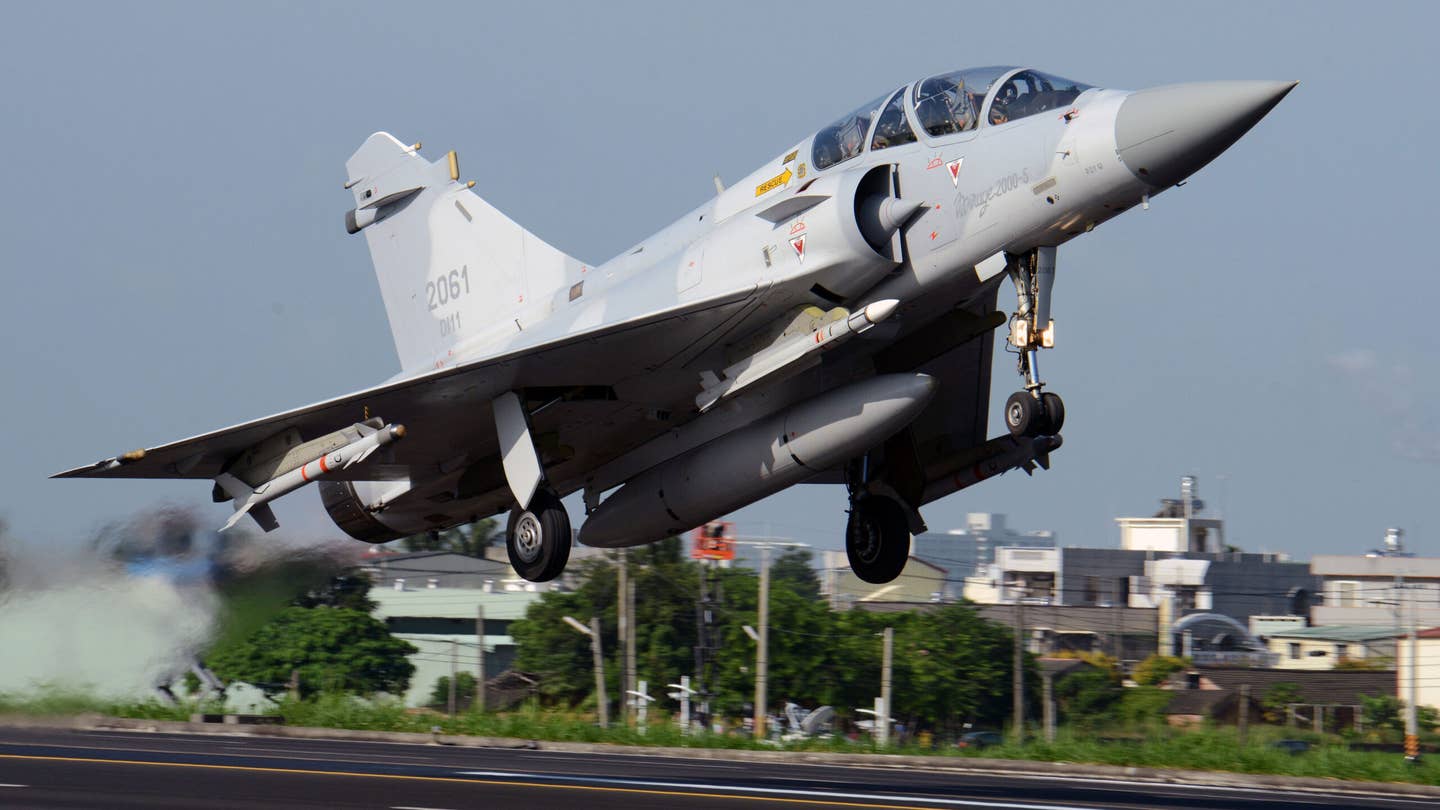Taiwan Looks To Upgrade Mirage 2000s To Bridge F-16 Delays
With a holdup in the delivery of long-awaited F-16 Block 70s, Taiwan is looking at extending the service life of some of its aging Mirages.

Taiwan is looking at extending the service life of a portion of its Mirage 2000-5 fighters as it grapples with potential delays in receiving 66 new F-16C/D Block 70 jets from the United States. With concerns over potential Chinese aggression against Taiwan only growing, alongside an uptick in Chinese military aircraft activity around the island, the capabilities of Taiwan’s fighter fleet are increasingly under scrutiny.
According to a statement yesterday from Taiwan’s Air Force Command Headquarters, a study is now underway into the feasibility of extending the service life of nine of its 54 surviving Mirage 2000-5s. This was reported by Taiwan’s semi-official Central News Agency (CNA), which stated that the plan was based on “both strategic and risk-hedging reasons.”
The nine aircraft to be modernized would all be two-seaters, which is judged more cost-effective since these jets have a dual air defense and training role. However, there’s no reason why the same program couldn’t also be extended to single-seaters in the future, funds permitting.
The Republic of China Air Force (ROCAF) says that it’s working alongside the original equipment manufacturer, Dassault Aviation, as part of the evaluation, which will assess whether the jets in question can serve for another 20 years.
The ROCAF is reportedly paying $4.77 million for the study, which is scheduled to be completed by July 2026. While unclear from the reports so far, the relatively long timeline suggests that this could well be more than theoretical work and may also involve actual modernization of at least some of the aircraft earmarked.
Tellingly, CNA reports that the Mirages are the costliest fighters in the ROCAF inventory, based on maintenance and repair requirements.
This is also a result of the age of these jets, which were delivered between 1997 and 1998.
Taiwan originally ordered 60 of the French-made fighters, comprising 48 single-seat Mirage 2000-5EI and 12 two-seat Mirage 2000-5DI variants. That deal was worth $3.8 billion, excluding weapons and other items, and was known as Project Fei Long (Flying Dragon).
In the meantime, the United States had approved the sale of F-16A/Bs to Taiwan, but the country was keen to diversify its fighter fleet and avoid reliance on a single source of this vital equipment, which could be compromised in times of crisis, or even depending on U.S. relations with China.
Meanwhile, the ROCAF’s Mirages are prized for their performance, in particular their rapid rate of climb, which reportedly led to the decision to base them in Hsinchu, close to the Chinese mainland, from where they are best suited to quickly intercept intruding aircraft.
ROCAF Mirages are armed with MBDA MICA air-to-air missiles, with active-radar guidance, as well as infrared-homing Magic II missiles. While air defense is their primary mission, the jets can also carry the Thales ASTAC pod for electronic intelligence (ELINT).
The Mirages are also deployed elsewhere, including rotations to Taitung County from where they can defend the southeastern part of the island.
However, the Taiwanese Mirage fleet has also faced some issues, especially related to maintenance. This has been reflected in the high level of support and life-cycle costs. According to Roy Choo and Peter Ho, in their authoritative study of the modern ROCAF, the Mirage 2000-5 costs the ROCAF $28,500 for each flight hour, compared to $5,700 for the F-16A/B, and $8,900 for the F-CK-1 Indigenous Defense Fighter. A number of Mirages have been placed in rotational storage to help mitigate this problem.
Bearing this in mind, it’s clear that the decision to assess a Mirage service-life extension is being driven by very real concerns about availability across all three fighter fleets. Indeed, thought had previously been given to a modernization program for the jets, but this was apparently rejected on cost grounds, as well as the inability of the French-made fighter to be integrated into Taiwan’s C4ISR network, known as Hsun’an.
There were also rumors that the Mirage 2000-5 might be replaced entirely by the F-16C/D Block 70. In the meantime, modernization programs were undertaken for the surviving F-16A/Bs and F-CK-1s. The early-model F-16s have now re-entered service in upgraded F-16V form, which you can read more about here. 141 F-16A/Bs are being upgraded to F-16V standard.
The service also operates around 129 upgraded F-CK-1s, which also now include a standoff cruise missile capability, which you can read more about here.
Now, in a possible turnaround, at least some of the Mirages will be retained longer to mitigate delays in deliveries of the new-build F-16s.
According to CNA, the first two of the 66 F-16C/Ds were to be delivered by the end of this year, but this has now been pushed back until the third quarter of 2024.
With the requirement for new fighters becoming more urgent, the Taiwanese deal for F-16C/D Block 70s was approved by the Trump administration in August 2019. The acquisition program is known as Feng Xiang (Phoenix Soaring).
The fact that Washington finally approved the sale of these advanced fighters was an important milestone in itself, the deal being a ‘red line’ issue for the government in Beijing, while successive U.S. administrations had refused to allow more modern F-16 versions to be delivered.
These new jets will bring advanced capabilities including active electronically scanned array (AESA) radars, conformal fuel tanks, an advanced electronic warfare suite, and an increased weapons load. As such, they will help address the growing qualitative gap between the ROCAF and China’s increasingly sophisticated air arms.
The current situation faced by the ROCAF, and the broader Republic of China Armed Forces, highlights the importance of both fighter numbers and capabilities.
In recent years, the Chinese military has repeatedly set new records for aircraft incursions into Taiwan’s Air Defense Identification Zone, or ADIZ. At the same time, it’s important to remember that Taiwan’s ADIZ covers not only the entirety of the strategic Taiwan Strait but also portions of mainland China, too.
Regardless, these spikes in activity by Chinese military aircraft and naval vessels play into growing fears about a Chinese military intervention on the island. Defense officials in both Taiwan and the United States have presented increasingly pessimistic predictions about when China will be fully prepared to launch a full-scale invasion of what it sees as a rogue province that is fully within its sovereign territory.
Meanwhile, although U.S. President Joe Biden has said in the past that the U.S. military would defend Taiwan if China attacked it, he has also stepped back from a commitment to send troops, in line with the Taiwan Relations Act.
Taken together, it’s clear that, despite its problems, the Taiwanese Mirage 2000-5 fleet still potentially has considerable relevance for the island’s defense strategy. With delays to the new F-16C/D Block 70s seemingly confirmed, it’s perhaps not a surprise that the Republic of China Air Force is seriously looking at extending the service career of a portion of the French-made jets to bridge this gap.
Contact the author: thomas@thedrive.com
